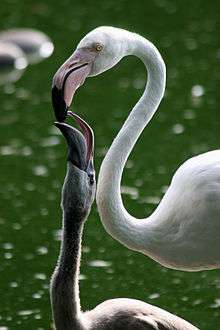Crop milk
Crop milk is a secretion from the lining of the crop of parent birds that is regurgitated to young birds. It is found among all pigeons and doves where it is referred to as pigeon milk. An analog to crop milk is also secreted from the esophagus of flamingos and the male emperor penguin.[1][2][3]

Comparison to mammalian milk
Crop milk bears little physical resemblance to mammalian milk, the former being a semi-solid substance somewhat like pale yellow cottage cheese. It is extremely high in protein and fat, containing higher levels than cow or human milk.[4] It has also been shown to contain anti-oxidants and immune-enhancing factors.[5] Like mammalian milk, crop milk contains IgA antibodies. It also contains some bacteria.[6] Unlike mammalian milk, which is an emulsion, pigeon crop milk consists of a suspension of protein-rich and fat-rich cells that proliferate and detach from the lining of the crop.[7] Lactation in birds is also controlled by prolactin, which is the same hormone that causes lactation in mammals.[6]
Feeding nestlings
Pigeon's milk begins to be produced a couple of days before the eggs are due to hatch. The parents may cease to eat at this point in order to be able to provide the squabs (baby pigeons and doves) with milk uncontaminated by seeds, which the very young squabs would be unable to digest. The baby squabs are fed on pure crop milk for the first week or so of life. After this the parents begin to introduce a proportion of adult food, softened by spending time in the moist conditions of the adult crop, into the mix fed to the squabs, until by the end of the second week they are being fed entirely on softened adult food.
Pigeons normally lay two eggs. If one egg fails to hatch, the surviving squab gets the advantage of a supply of crop milk sufficient for two squabs and grows at a significantly faster rate.[8] Research suggests that a pair of breeding pigeons cannot produce enough crop milk to feed three squabs adequately, which explains why clutches are limited to two.[9]
Cultural references
- In Animal Crossing: Wild World for the Nintendo DS, Animal Crossing: City Folk for the Wii, and Animal Crossing: New Leaf for the Nintendo 3DS, a character named Brewster uses it as an ingredient when serving coffee to long-time customers.
- In season 2 of the reality TV series Flavor of Love, Deelishis' father requests a carton of pigeon milk at dinner.
- Ptasie mleczko (Polish: bird milk) is the name of Polish candy, which variations are also popular in Eastern Europe countries as Ptichye Moloko (Russian: птичье молоко), ptashyne moloko (Ukrainian: птaшине молоко).
References
- Levi, Wendell (1977). The Pigeon. Sumter, S.C.: Levi Publishing Co, Inc. ISBN 0-85390-013-2.
- Silver, Rae (1984). "Prolactin and Parenting in the Pigeon Family" (PDF). The Journal of Experimental Zoology. 232 (3): 617–625. doi:10.1002/jez.1402320330. PMID 6394702. Archived from the original on 2016-09-13.CS1 maint: BOT: original-url status unknown (link)
- Eraud, C., Dorie, A., Jacquet, A. and Faivre, B. (2008). "The crop milk: a potential new route for carotenoid-mediated parental effects". Journal of Avian Biology. 39 (2): 247–251. doi:10.1111/j.0908-8857.2008.04053.x.CS1 maint: multiple names: authors list (link)
- Ehrlich, Paul R.; Dobkin, David S. and Wheye, Darryl (1988) Bird Milk. stanford.edu
- "Mysteries of pigeon milk explained" Archived 2011-09-24 at the Wayback Machine Retrieved September 22, 2011
- Gillespie, M. J.; Stanley, D.; Chen, H.; Donald, J. A.; Nicholas, K. R.; Moore, R. J.; Crowley, T. M. (2012). Salmon, Henri (ed.). "Functional Similarities between Pigeon 'Milk' and Mammalian Milk: Induction of Immune Gene Expression and Modification of the Microbiota". PLoS ONE. 7 (10): e48363. doi:10.1371/journal.pone.0048363. PMC 3482181. PMID 23110233.
- Gillespie, M. J.; Haring, V. R.; McColl, K. A.; Monaghan, P.; Donald, J. A.; Nicholas, K. R.; Moore, R. J.; Crowley, T. M. (2011). "Histological and global gene expression analysis of the 'lactating' pigeon crop". BMC Genomics. 12: 452. doi:10.1186/1471-2164-12-452. PMC 3191541. PMID 21929790.
- Vandeputte-Poma, J.; van Grembergen, G. (1967). "L'evolution postembryonnaire du poids du pigeon domestique". Zeitschrift für vergleichende Physiologie. 54 (3): 423–425. doi:10.1007/BF00298228.
- Blockstein, David E. (1989). "Crop milk and clutch size in mourning doves". The Wilson Bulletin. 101 (1): 11–25. JSTOR 4162684.
The fact that none of the nearly 300 species of Columbiformes has a clutch size larger than two eggs suggests that there is limited plasticity in crop-milk production.